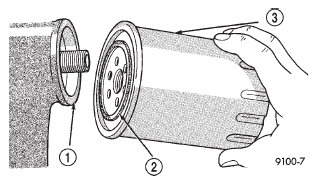Repair damaged or worn threads. Cylinder bore-honing
CAUTION: Be sure that the tapped holes maintain
the original center line.
1 - SEALING SURFACE 2 - RUBBER GASKET 3 - OIL FILTER Damaged or worn threads can be repaired. Essentially,
this repair consists of: Before honing, stuff plenty of clean shop towels
under the bores and over the crankshaft to keep
abrasive materials from entering the crankshaft
area.
(1) Used carefully, the Cylinder Bore Sizing Hone
C-823, equipped with 220 grit stones, is the best tool
for this job. In addition to deglazing, it will reduce
taper and out-of-round, as well as removing light
scuffing, scoring and scratches. Usually, a few strokes
will clean up a bore and maintain the required limits. CAUTION: DO NOT use rigid type hones to remove
cylinder wall glaze. (2) Deglazing of the cylinder walls may be done if
the cylinder bore is straight and round. Use a cylinder
surfacing hone, Honing Tool C-3501, equipped
with 280 grit stones (C-3501-3810). about 20-60
strokes, depending on the bore condition, will be sufficient
to provide a satisfactory surface. Using honing
oil C-3501-3880, or a light honing oil, available from
major oil distributors. CAUTION: DO NOT use engine or transmission oil,
mineral spirits, or kerosene. (3) Honing should be done by moving the hone up
and down fast enough to get a crosshatch pattern.
The hone marks should INTERSECT at 50 to 60
for proper seating of rings (Fig. 9).
(4) A controlled hone motor speed between 200 and
300 RPM is necessary to obtain the proper crosshatch
angle. The number of up and down strokes per
minute can be regulated to get the desired 50 to 60
angle. Faster up and down strokes increase the crosshatch
angle.
(5) After honing, it is necessary that the block be
cleaned to remove all traces of abrasive. Use a brush
to wash parts with a solution of hot water and detergent.
Dry parts thoroughly. Use a clean, white, lintfree
cloth to check that the bore is clean. Oil the
bores after cleaning to prevent rusting. The hone marks should INTERSECT at 50 to 60
for proper seating of rings (Fig. 9).
Repair damaged or worn threads
 Fig. 8 Oil Filter Sealing Surface-Typical
Fig. 8 Oil Filter Sealing Surface-Typical
Cylinder bore-honing
 Fig. 9 Cylinder Bore Crosshatch Pattern
Fig. 9 Cylinder Bore Crosshatch Pattern
Dodge Durango (DN) 1998-2003 Service Manual
- Lubrication and Maintenance
- Suspension
- Differential and Driveline
- Brakes
- Cooling System
- Battery
- Starting Systems
- Charging System
- Ignition System
- Instrument Panel Systems
- Audio Systems
- Horn Systems
- Speed Control System
- Turn Signal and Hazard Warning Systems
- Wiper and Washer Systems
- Lamps
- Passive Restraint Systems
- Electrically Heated Systems
- Power Distribution System
- Power Lock Systems
- Vehicle Theft/Security Systems
- Power Seat System
- Power Window Systems
- Power Mirror Systems
- Chime/Buzzer Warning Systems
- Overhead Console Systems
- Engine
- Exhaust System
- Frame and Bumpers
- Fuel System
- Steering
- Transmission and Transfer Case
- Tires and Wheels
- Body
- Heating and Air Conditioning
- Emission Control Systems
- Introduction
